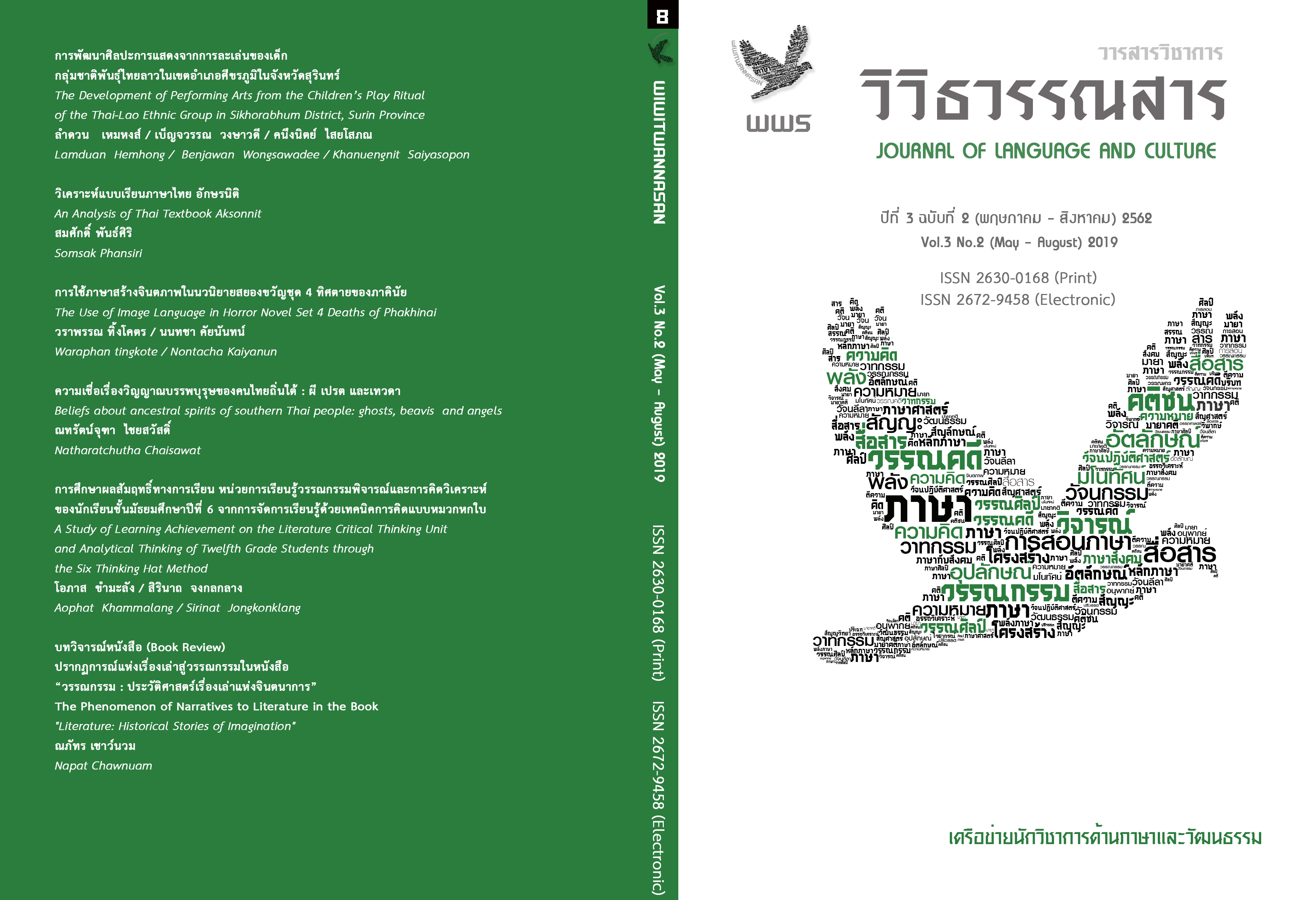การพัฒนาศิลปะการแสดงจากการละเล่นของเด็ก กลุ่มชาติพันธุ์ลาวในเขตอำเภอศีขรภูมิในจังหวัดสุรินทร์
Main Article Content
บทคัดย่อ
การวิจัยครั้งนี้มีวัตถุประสงค์ 1) เพื่อศึกษาการละเล่นของกลุ่มชาติพันธุ์ไทยลาว ในเขตอำเภอศีขรภูมิจังหวัดสุรินทร์ และ 2) เพื่อพัฒนาศิลปะการแสดงจากการละเล่นกลุ่มชาติพันธุ์ไทยลาว ในเขตอำเภอศีขรภูมิจังหวัดสุรินทร์ เป็นการวิจัยเชิงคุณภาพ ด้วยเทคนิควิธีการสังเกต สัมภาษณ์และการประชุมกลุ่มย่อย จากกลุ่มผู้รู้ ผู้ปฎิบัติและผู้ให้ข้อมูลทั่วไปในเขตอำเภอศีขรภูมิ จังหวัดสุรินทร์
ผลการวิจัยพบว่าความเป็นมาการละเล่นของเด็กกลุ่มชาติพันธุ์ไทยลาว ถือเป็นภูมิปัญญาท้องถิ่นที่เกิดจากความคิดความต้องการเล่นเพื่อความสนุกสนานตามวัยของเด็ก แล้วเรียนรู้สืบทอดกันมา โดยการปรับเปลี่ยนและเพิ่มเติมให้เหมาะสมตามสภาพบริบทสังคมที่เปลี่ยนไป ซึ่งแบ่งตามวิธีการเล่นได้ 10 ประเภทคือ ประเภทเสี่ยงทายหรือคัดออก ประเภทไล่จับ ประเภทกระโดด ประเภทการดึง ประเภทการร้องเล่น ประเภทเล่นเดี่ยว ประเภทแม่นยำ ประเภททาย ประเภทซ่อนหา และประเภทเลียนแบบ การเล่นมักเล่นไม่จำกัดจำนวน อุปกรณ์การเล่นเป็นสิ่งที่มีอยู่ในท้องถิ่น เพลงประกอบเป็นเพลงสั้น ๆ มีความตลก มีภาษาถิ่นปน บ่งบอกวิถีชีวิตของคนในชีวิตของท้องถิ่น การเล่นมีความสำคัญอย่างยิ่งต่อพัฒนาร่างกายให้แข็งแรง ให้รู้สึกอารมณ์สนุกสนานเพลิดเพลิน ได้เรียนรู้การอยู่ร่วมกันกับผู้อื่น รู้แพ้ รู้ชนะ รู้อภัย เคารพกฎ กติกามารยาทของสังคม ส่งเสริมให้เกิดความรักความสามัคคีในหมู่คณะ ช่วยให้เด็กมีจินตนาการ ปฏิภาณไหวพริบ แก้ปัญหาได้
การพัฒนาศิลปะการแสดงจากการละเล่นของเด็กกลุ่มชาติพันธุ์ไทยลาว ใช้ทำนองเพลงพื้นเมืองอีสานแต่งกายนุ่งโจงกระเบนและพันผ้ารอบอกด้วยสไบพื้นเมืองใช้ ประดับด้วยเครื่องเงิน ลีลาท่ารำเป็นที่ประยุกต์ผสมผสานท่ารำพื้นฐานที่สื่อให้เห็นถึงรูปแบบวิธีการละเล่นของเด็ก แบ่ง ออกเป็น 9 ช่วง โดยช่วงที่ 1 ท่าออกชวนเพื่อนมาเล่น ช่วงที่ 2 การตกลงก่อนเล่น การโอหวายแป๊ะ ต่อด้วย ตีโป้ง ช่วงที่ 3 การเล่นมอญซ่อนผ้า ช่วงที่ 4 การเสือข้ามห้วย ช่วงที่ 5 การเล่นโค้งตีน ต่อด้วย ตีโป้ง ช่วงที่ 3 การเล่นมอญซ่อนผ้า ช่วงที่ 4 การเสือข้ามห้วย ช่วงที่ 5 การเล่นโค้งตีนเกวียน ช่วงที่ 6 การเล่นรีรีข้าวสารช่วงที่ 7 การเล่นบักยาดหมู่ ช่วงที่ 8 การเล่นหมอลำ ช่วงที่ 9 จบการเล่นด้วยท่าลา ประโยชน์ที่ได้รับนอกเหนือจากการสร้างความสุนทรีย์ด้านการบันเทิงแล้วยังเป็นการแสดงที่เสริมสร้างพัฒนาการทางด้านร่างกาย อารมณ์ สังคม และสติปัญญาให้กับเด็ก ทั้งยังเป็นการอนุรักษ์และสืบสานภูมิปัญญาการละเล่นที่ทรงคุณค่าให้คงอยู่คู่ท้องถิ่นสืบไปด้วย
Article Details
ลิขสิทธิ์ของบทความเป็นของวารสาร การพิมพ์ซ้ำจะต้องได้ร้บการอนุญาตจากบรรณาธิการวารสาร
เอกสารอ้างอิง
thangkan rian khanittasat khong nakrian chan prathomsueksa pi thi 1. (In Thai) [The Effect of Application of Thai
Traditional Play on Mathematics Learning Achievement of Grade 1 Students]. (Master’s Thesis). Chulalongkorn
University, Bangkok.
Chara, A. (2010). Kan lalen phuenban thai. (In Thai) [Thai Folk Play]. Pathum Thani: PNK And Sky Printing.
Chimphanao, S. (1994). Kan lalen khong dek thai nai adit. (In Thai) [Play of Thai Children in the Past]. Chiang Mai:
Chiang Mai Book Center.
Pasand,F.et al. (2014). Impact of Traditional Exercises on Perceptual- Motor Development in Elementary School Girl
Students. Indian Journal of Fundamental and Applied Life Sciences, 4 (S3): 1297-1302.
Hemhong, L. (2011, May 19). Personal Interview.
Manchit, S. (2011, October 20). Personal Interview.
Promphan, S.et al. (2007). Kan soemsang khwam chalat thang arom khong dek wai 9-11 pi doi chai kitchakam kan len.
(In Thai) [Increasing Emotional Intelligence of Children Aged 9-11 by Play Activities]. The 6th International
Conference on Mental Health: City Life, on August, 1-3, 2007, at the Prince Palace Hotel, Bangkok.
Schneps, J. S. (2002). Language, Social Skill and Behavior Problems in Preschool Children, Dissertation Abstracts
International, 63(4): 2092 -B.
Soranet, B. (2011, May 19). Personal Interview.
Sukthitiphat, D. (2010). Phon kan chat kitchakam kan lalen phuenban thai phuea phatthana thaksa phuenthan thang
khanittasat khong dek pathommawai. (In Thai) [The Results of Organizing Thai Folk Play for Developing Basic
Math Skills of Preschool Children]. (Master’s Thesis). Phetchaburi Rajabhat University, Phetchaburi.
Thawonrak, U. (2012). Suepthot sinlapa kan sadaeng phuenban chao kariang Amphoe Si Sawat Changwat
Kanchanaburi. (In Thai) [Preservation, Inheriting Local Art performance of Karan ‘Ratong’ of Sisawat district,
Kanchanaburi province]. Kanchanaburi: Kanchanaburi Art and Religious Promotion Section.


